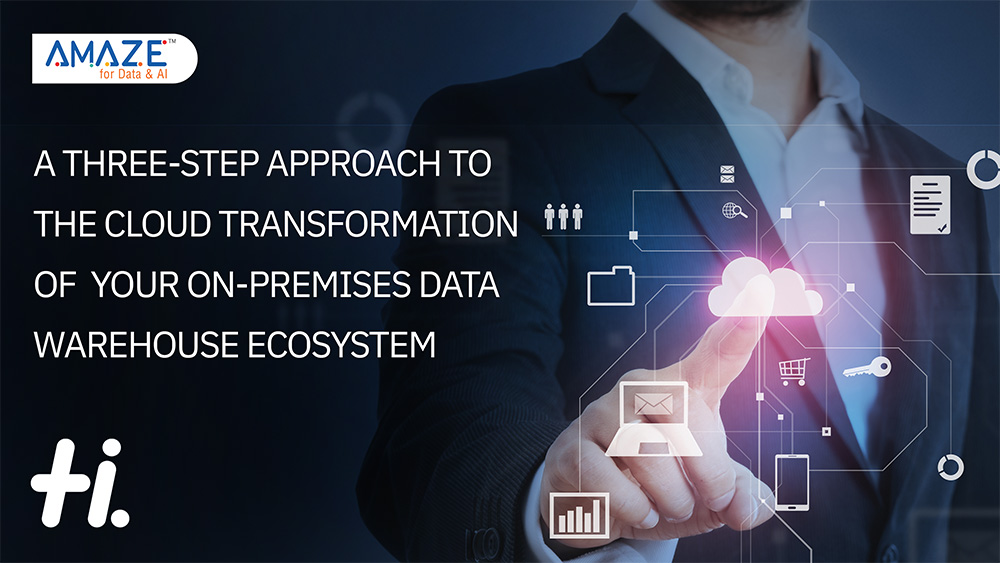
Cloud data warehouse adoption is booming. Valued at $21.18bn in 2021, Allied Market Research projects this sector to more than double (to $51.18bn) by 2028.
Covid-19 has turbocharged a major migration of data warehouses to the cloud. With a new-rules-of-hybrid-work model emerging, enterprises are prizing agility, flexibility and cost optimisation like never before – and pushing digital transformation strategy to the top of the corporate agenda.
As businesses strive to better harness the powers of data, the current on-premises MPP appliances – such as Teradata, Netezza and Exadata – are proving increasingly antiquated and inadequate. Leaving aside matching the advanced features of the cloud, such as low costs and high security, the on-premise data warehouse often fails to address even the basic business needs of today, such as insights from large volumes of real-time data, agile scaling up and down of compute, and storage based on business traffic demand. In this context, the case for enterprises to move to the cloud is only becoming more compelling.

However, deciding to embrace the cloud is only the first step. Once the decision is made, the next and the more important phase in what can be a complicated and challenging journey, is how to ensure it is done correctly?’
The cost savings, innovation and business optimisation promised by the cloud are undeniable, but an “improper” migration can quickly undo many of those benefits. A 2021 McKinsey & Company report warns us about $100bn of wasted migration spends predicted over the next three years. Seventy-five per cent of respondents, in McKinsey’s global survey of 450 CIOs and IT decision makers, reported migration costs having run over budget, and 38% acknowledged their cloud migration efforts were running behind schedule.
A ‘data-driven organisation’ vision
“The pandemic has certainly accelerated activity around data warehouse migration, but actually it’s a trend that precedes Covid-19,” says Prasad Karkhanis, assistant vice president, data and analytics at Hexaware. “Beyond the savings gained in storage through moving to cloud, enterprises need to explore the holistic benefits of becoming a data-driven organisation. Deeply examine the advantages cloud offers over traditional solutions. On-premises environments require a longer time to enable data-driven decision making – and anything that’s slower is not good for business.”
Indeed, in an increasingly data-driven world, speed is of the essence. Karkhanis stresses that this is true for both internal and external data monetisation. With your analytics infrastructure needing to be able to support all types of quick analysis and execution across all data layers and user levels, cloud offers faster and more powerful facilitation of these requirements.
The migration timeline is also a key factor. To maximise the chances of migration success requires a clear and comprehensive picture of the current state of your warehouse, across its three fundamental layers – data; data pipeline; and data visualisation.
“When we talk about data warehouse migration, it’s important that we look at all three layers simultaneously and consider how best they can each be brought across to a cloud platform,” Karkhanis explains. “One should start with data and data pipeline in parallel and, once you have your first iteration of migration completed (and the data is in your cloud data warehouse), only then start thinking about the visualisation pieces.”
Move smartly
But a major challenge for enterprises is deciding how and where they are moving those layers. With a proliferation of cloud players offering a large array of platforms and services (AWS has Redshift, Microsoft offers Synapse, while Google promotes BigQuery) added on by platforms (such as Snowflake) which run across all three major cloud platforms, selection is a challenge in itself.
“There are multiple choices,” acknowledges Karkhanis. “The same applies to data pipeline and visualisation. The migration process, right from choosing the correct platform to planning and executing it, can be overwhelming. And that’s where Hexaware can really help you. Looking at an enterprise’s current state, defining the optimal future state they can go for, then preparing for and executing the journey.”
The above three phases are automatedly executed by Amaze for Data & AI, Hexaware’s proprietary platform which harnesses automation to enable rapid transformation and deployment of data and analytics ecosystems onto leading public cloud platforms – Microsoft Azure, AWS, Google Cloud Platform, Databricks and Snowflake – all of whom are Hexaware strategic partners. “The real value we deliver is by holistically planning the best migration roadmap suited for your unique needs and then migrating all the three layers to the cloud through our proprietary automated and smart transformation platform,” says Karkhanis.
For businesses that are yet to define their target state environment or are unsure about what platform is best suited for them, Amaze for Data & AI can help by conducting an in-depth scoping and analysis. The analysis is done via a dual combo of an automated assessment of the technical landscape and data collection through a cloud-readiness questionnaire that gauges business requirements.
Asking the right questions
“We ask both tech and business questions, helping define the ‘best’ target state suited to our client’s specific needs,” Karkhanis says. “There is no universal ‘best target cloud’ that exists when it comes to transforming your data warehouse; it is highly context driven. Determining the ‘best target’ unique to your needs is a combination of multiple factors that are identified during the preliminary assessment; inputs from both the questionnaire and automated assessment that ultimately define which cloud data platform will be ideal for you.
“There is no universal ‘best target cloud’ that exists when it comes to transforming your data warehouse; it is highly context driven.”
Prasad Karkhanis, Hexaware
“Once the target state has been proposed, the next step is a super-detailed automated deep-dive assessment, using Amaze for Data and AI, which analyses the current landscape. It then produces a complete inventory across all three layers and provides a comprehensive complexity report and fit-gap analysis which helps estimate the work volume and plan the entire transformation. Based on these reports, we are able to give our clients a reliable, data-backed estimate of the planned transformation: ‘This is the level of complexity of your landscape; these components requires manual intervention based on their complexity; and this is the timeframe within which we can deliver the promised migration.’ We are thus able to confidently provide a transformation roadmap and a precise timeline for our client’s ecosystem across all the three layers.”
Amaze for Data & AI’s ability to analyse, prepare and migrate all three of those layers is a major differentiator. This, combined with end-to-end automation of the entire process, minimises the need for manual interventions. This can accelerate migration timelines by 40% to 60% compared to a traditional manual approach, reduce TCO by about 50% and provide cost savings of about 50%. The phased migration strategy also promises minimal disruptions to one’s actual business.
“For larger enterprises, we propose an MVP based approach transforming the entire data warehouse in multiple agile sprints,” Karkhanis says. “We then recommend production releases going by user communities/business functions – finance, operations, sales, marketing, and so on – getting each team up and running in the new data warehouse one-by-one. Therefore, minimising any risks and preventing business disruption during cut-over.”
Reducing risks and costs, while ensuring agility, flexibility, security and hyper-availability of real-time data and analytics, lies at the heart of the Amaze value proposition.
“With enterprises increasingly recognising the need for and the benefits of migrating their data warehouses to the cloud, change is inevitable,” Karkhanis concludes. “The leaders responsible for this change, however, need to ensure that they undertake this journey only once, and that they have a holistic strategy and a trusted partner by their side. Otherwise, they risk ending up on the ‘dark side of the cloud’.”








